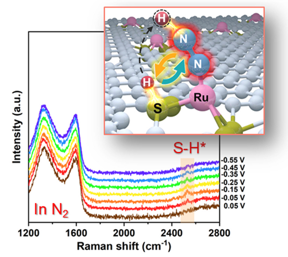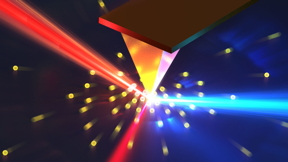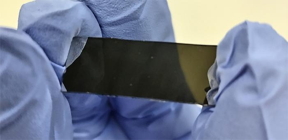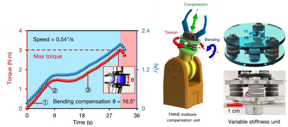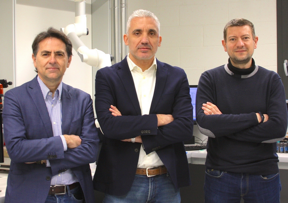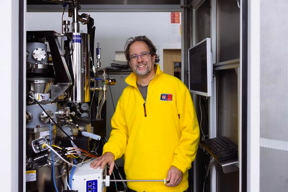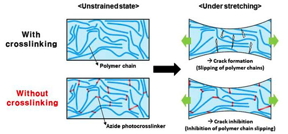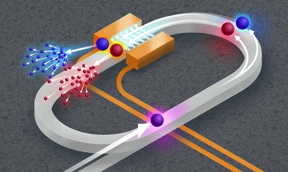Home > Press > First direct imaging of small noble gas clusters at room temperature: Novel opportunities in quantum technology and condensed matter physics opened by noble gas atoms confined between graphene layers
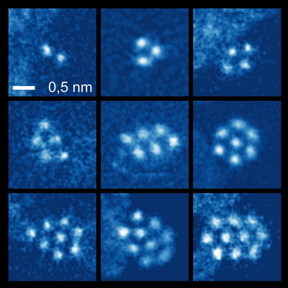 |
| Xenon nanoclusters between two graphene layers, with sizes between two and ten atoms. CREDIT Manuel Längle |
Abstract:
For the first time, scientists have succeeded in the stabilisation and direct imaging of small clusters of noble gas atoms at room temperature. This achievement opens up exciting possibilities for fundamental research in condensed matter physics and applications in quantum information technology. The key to this breakthrough, achieved by scientists at the University of Vienna in collaboration with colleagues at the University of Helsinki, was the confinement of noble gas atoms between two layers of graphene. This method overcomes the difficulty that noble gases do not form stable structures under experimental conditions at ambient temperatures. Details of the method and the first ever electron microscopy images of noble gas structures (krypton and xenon) have now been published in Nature Materials.
First direct imaging of small noble gas clusters at room temperature: Novel opportunities in quantum technology and condensed matter physics opened by noble gas atoms confined between graphene layers
Vienna, Austria | Posted on January 12th, 2024A Noble Trap
Jani Kotakoski's group at the University of Vienna was investigating the use of ion irradiation to modify the properties of graphene and other two-dimensional materials when they noticed something unusual: when noble gases are used to irradiate, they can get trapped between two sheets of graphene. This happens when noble gas ions are fast enough to pass through the first but not the second graphene layer. Once trapped between the layers, the noble gases are free to move. This is because they do not form chemical bonds. However, in order to accommodate the noble gas atoms, the graphene bends to form tiny pockets. Here, two or more noble gas atoms can meet and form regular, densely packed, two-dimensional noble gas nanoclusters.
Fun with Microscope
"We used scanning transmission electron microscopy to observe these clusters, and they are really fascinating and a lot of fun to watch. They rotate, jump, grow and shrink as we image them", says Manuel Längle, lead author of the study. "Getting the atoms between the layers was the hardest part of the work. Now that we have achieved this, we have a simple system for studying fundamental processes related to material growth and behavior ", he adds. Commenting on the group's future work, Jani Kotakoski says: "The next steps are to study the properties of clusters with different noble gases and how they behave at low and high temperatures. Due to the use of noble gases in light sources and lasers, these new structures may in future enable applications for example in quantum information technology."
####
For more information, please click here
Contacts:
Media Contact
Alexandra Frey
University of Vienna
Office: 01-4277
Expert Contact
Manuel Längle, MSc
University of Vienna
Office: +43-1-4277-728 37
Copyright © University of Vienna
If you have a comment, please Contact us.Issuers of news releases, not 7th Wave, Inc. or Nanotechnology Now, are solely responsible for the accuracy of the content.
| Related Links |
| Related News Press |
News and information
![]() Researchers develop technique to synthesize water-soluble alloy nanoclusters January 12th, 2024
Researchers develop technique to synthesize water-soluble alloy nanoclusters January 12th, 2024
![]() Rice University launches Rice Synthetic Biology Institute to improve lives January 12th, 2024
Rice University launches Rice Synthetic Biology Institute to improve lives January 12th, 2024
Graphene/ Graphite
2 Dimensional Materials
![]() 'Sudden death' of quantum fluctuations defies current theories of superconductivity: Study challenges the conventional wisdom of superconducting quantum transitions January 12th, 2024
'Sudden death' of quantum fluctuations defies current theories of superconductivity: Study challenges the conventional wisdom of superconducting quantum transitions January 12th, 2024
![]() What a “2D” quantum superfluid feels like to the touch November 3rd, 2023
What a “2D” quantum superfluid feels like to the touch November 3rd, 2023
Imaging
![]() The USTC realizes In situ electron paramagnetic resonance spectroscopy using single nanodiamond sensors November 3rd, 2023
The USTC realizes In situ electron paramagnetic resonance spectroscopy using single nanodiamond sensors November 3rd, 2023
![]() Observation of left and right at nanoscale with optical force October 6th, 2023
Observation of left and right at nanoscale with optical force October 6th, 2023
Possible Futures
![]() Focused ion beam technology: A single tool for a wide range of applications January 12th, 2024
Focused ion beam technology: A single tool for a wide range of applications January 12th, 2024
![]() 'Sudden death' of quantum fluctuations defies current theories of superconductivity: Study challenges the conventional wisdom of superconducting quantum transitions January 12th, 2024
'Sudden death' of quantum fluctuations defies current theories of superconductivity: Study challenges the conventional wisdom of superconducting quantum transitions January 12th, 2024
![]() Rice University launches Rice Synthetic Biology Institute to improve lives January 12th, 2024
Rice University launches Rice Synthetic Biology Institute to improve lives January 12th, 2024
Discoveries
![]() Focused ion beam technology: A single tool for a wide range of applications January 12th, 2024
Focused ion beam technology: A single tool for a wide range of applications January 12th, 2024
![]() 'Sudden death' of quantum fluctuations defies current theories of superconductivity: Study challenges the conventional wisdom of superconducting quantum transitions January 12th, 2024
'Sudden death' of quantum fluctuations defies current theories of superconductivity: Study challenges the conventional wisdom of superconducting quantum transitions January 12th, 2024
![]() Development of zinc oxide nanopagoda array photoelectrode: photoelectrochemical water-splitting hydrogen production January 12th, 2024
Development of zinc oxide nanopagoda array photoelectrode: photoelectrochemical water-splitting hydrogen production January 12th, 2024
Announcements
![]() Researchers develop technique to synthesize water-soluble alloy nanoclusters January 12th, 2024
Researchers develop technique to synthesize water-soluble alloy nanoclusters January 12th, 2024
![]() Scientists use heat to create transformations between skyrmions and antiskyrmions January 12th, 2024
Scientists use heat to create transformations between skyrmions and antiskyrmions January 12th, 2024
![]() Bridging light and electrons January 12th, 2024
Bridging light and electrons January 12th, 2024
Interviews/Book Reviews/Essays/Reports/Podcasts/Journals/White papers/Posters
![]() Focused ion beam technology: A single tool for a wide range of applications January 12th, 2024
Focused ion beam technology: A single tool for a wide range of applications January 12th, 2024
![]() 'Sudden death' of quantum fluctuations defies current theories of superconductivity: Study challenges the conventional wisdom of superconducting quantum transitions January 12th, 2024
'Sudden death' of quantum fluctuations defies current theories of superconductivity: Study challenges the conventional wisdom of superconducting quantum transitions January 12th, 2024
![]() Development of zinc oxide nanopagoda array photoelectrode: photoelectrochemical water-splitting hydrogen production January 12th, 2024
Development of zinc oxide nanopagoda array photoelectrode: photoelectrochemical water-splitting hydrogen production January 12th, 2024
Tools
![]() Ferroelectrically modulate the Fermi level of graphene oxide to enhance SERS response November 3rd, 2023
Ferroelectrically modulate the Fermi level of graphene oxide to enhance SERS response November 3rd, 2023
![]() The USTC realizes In situ electron paramagnetic resonance spectroscopy using single nanodiamond sensors November 3rd, 2023
The USTC realizes In situ electron paramagnetic resonance spectroscopy using single nanodiamond sensors November 3rd, 2023
![]() Observation of left and right at nanoscale with optical force October 6th, 2023
Observation of left and right at nanoscale with optical force October 6th, 2023
- SEO Powered Content & PR Distribution. Get Amplified Today.
- PlatoData.Network Vertical Generative Ai. Empower Yourself. Access Here.
- PlatoAiStream. Web3 Intelligence. Knowledge Amplified. Access Here.
- PlatoESG. Carbon, CleanTech, Energy, Environment, Solar, Waste Management. Access Here.
- PlatoHealth. Biotech and Clinical Trials Intelligence. Access Here.
- Source: http://www.nanotech-now.com/news.cgi?story_id=57437
- :is
- :not
- $UP
- 000
- 10
- 12th
- 17th
- 27
- 3rd
- 6th
- 7th
- a
- AC
- accommodate
- accuracy
- achieved
- achievement
- acoustic
- Adds
- Alloy
- Ambient
- and
- applications
- ARE
- Array
- AS
- At
- Austria
- author
- awarded
- away
- BE
- Beam
- because
- been
- behavior
- between
- biology
- boasts
- Bonds
- breakthrough
- bulletproof
- but
- by
- CAN
- Can Get
- carbon
- Center
- CGI
- challenges
- chemical
- click
- co2
- collaboration
- colleagues
- COM
- comment
- Commenting
- commitment
- compatible
- Condensed matter
- conditions
- content
- conventional
- Conversion
- could
- create
- credit
- Current
- Death
- del
- details
- develop
- Development
- Devices
- different
- Difficulty
- direct
- discover
- do
- doesn
- due
- Emissions
- enable
- end
- energy
- enhance
- enough
- Ether (ETH)
- EVER
- example
- exciting
- experimental
- fascinating
- FAST
- feels
- films
- First
- first time
- fluctuations
- For
- form
- Foundation
- Free
- fun
- fundamental
- future
- futuristic
- GAS
- get
- getting
- gif
- Graphene
- greater
- greenhouse gas
- Group
- Grow
- Growth
- happens
- Harvesting
- Have
- he
- help
- here
- High
- How
- However
- http
- HTTPS
- hydrogen
- if
- image
- images
- Imaging
- improve
- in
- Inc.
- information
- information technology
- Institute
- ITS
- January
- jpg
- jump
- just
- Key
- krypton
- laser
- lasers
- launches
- layer
- layers
- lead
- left
- lenses
- Level
- light
- like
- links
- Lot
- Low
- material
- materials
- Matter
- May..
- Meet
- method
- Microscopy
- modify
- more
- move
- nanotechnology
- Nature
- net
- New
- news
- next
- Noble
- novel
- November
- now
- observe
- october
- of
- offset
- on
- once
- opened
- opens
- opportunities
- Optimize
- or
- order
- Other
- packed
- part
- pass
- Paul
- PHP
- Physics
- plato
- Plato Data Intelligence
- PlatoData
- please
- pockets
- possibilities
- Post
- posted
- potent
- power
- press
- Press Release
- processes
- properties
- published
- Quantum
- quantum information
- quantum technology
- range
- really
- regular
- related
- release
- Releases
- Renowned
- research
- researchers
- resonance
- responsible
- return
- Rice
- right
- Rival
- Room
- s
- Save
- says
- scanning
- scientists
- Search
- Second
- sensor
- sensors
- setup
- Share
- Simple
- single
- SIX
- sizes
- small
- solely
- solid
- something
- Sources
- Spectroscopy
- speed
- stable
- start
- Steps
- strength
- strong
- structures
- Study
- Studying
- submit
- sudden
- Superconductivity
- synthesize
- synthetic
- system
- Systems
- T
- Tandem
- technique
- Technology
- ten
- than
- that
- The
- Them
- These
- they
- this
- Through
- time
- times
- to
- tool
- transformations
- trapped
- two
- Ultra
- under
- university
- unusual
- us
- use
- used
- using
- USTC
- was
- Watch
- Wave
- we
- when
- wide
- Wide range
- will
- wisdom
- with
- Work
- Yahoo
- Yield
- you
- zephyrnet










